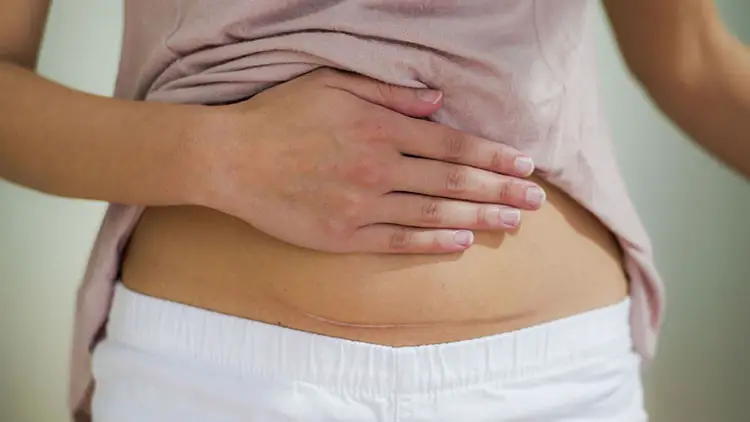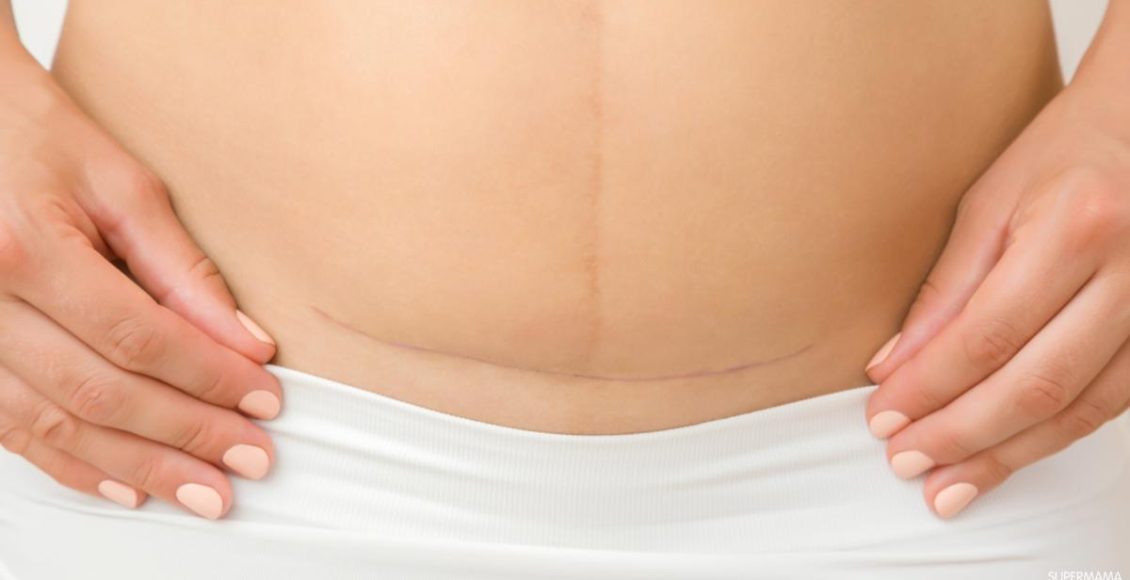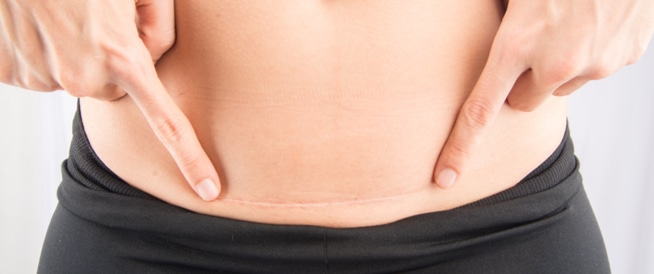Types of caesarean section sutures
Laser caesarean section suturing provides several advantages compared to traditional suturing, as it is considered easy to perform and does not require anesthesia.
However, severe bleeding can occur during and after childbirth as a result of a cesarean section.
They must be careful regarding the effects of anesthesia.
Reactions may occur to any type of anesthesia used.
There are several different types of suturing after a cesarean section.
Suturing is done either by stapling, cosmetic subcutaneous suture, or wound tape.
Each type of thread requires a period of time to be removed.
Internal cosmetic suturing requires a layer of skin under the wound.
There are two types of subcutaneous suture; They are the thread that does not dissolve and requires withdrawal after five to seven days, and the thread that gradually dissolves over five weeks.
One of the best types of caesarean section suturing is laser suturing, where doctors use a laser to treat surgery scars.
This process helps reduce scarring and improve the overall appearance of the wound.
The laser stitching process requires the use of silk threads.
The ancients believed that silk threads were the best for suturing wounds.
In addition, laser suturing is among the most popular and widely used types of caesarean section suturing.
How many layers are stitched during a cesarean section?
The caesarean section process takes time and effort from doctors to perform successfully.
Sources indicate that during a caesarean section, seven layers of skin and underlying tissue are opened until the abdominal muscles and uterine wall are reached.
This operation is considered a surgical procedure and is performed in the operating room under general or local anesthesia, depending on the woman’s health condition.
It is known that the number of layers that are stitched during a caesarean section is about seven layers, starting from the skin and ending with the skin as well.
Doctors use medical suture or cosmetic suture to close the wounds formed after the operation.
Cosmetic types of cesarean section sutures use threads that dissolve spontaneously over time.
After the wounds are closed, the woman is kept quiet for 4 to 6 hours without being allowed to take food or liquids.
When does the internal suture dissolve for cesarean section?
It turns out that there are two types of threads used in this process.
The first type is dissolvable threads that dissolve automatically within the body without the need for medical intervention.
According to medical sources, it dissolves within a period ranging between one and two weeks after the operation, as it dissolves automatically and disappears completely inside the body.
The second type is insoluble sutures, which require manual removal by the doctor within a period of one to two weeks after the procedure.
Therefore, the patient needs an appointment with the doctor to remove these sutures.
Dissolution time for caesarean section sutures can vary from person to person, depending on wound healing and healing factors.
In general, the importance of heeding any directions or instructions of the treating surgeon after the operation is emphasized.
Follow-up appointments may be organized to ensure proper wound healing and to remove the sutures to ensure patient safety.
Women should not rush to scrape or remove sutures without consulting a doctor, as this may increase the risk of infection or delay the wound healing process.
It is best to follow the post-operative care directions provided by your healthcare team, and as long as there are no signs of infection or abnormal symptoms, you can be confident that the wound is healing properly and the sutures are being resolved appropriately and spontaneously.
How do I know if I have adhesions after a cesarean section?
Uterine adhesions are one of the complications that may occur after a cesarean section.
These adhesions occur when scar tissue forms in the area of the cesarean section, causing the tissues surrounding the uterus to connect together.
Several signs and symptoms of adhesions may appear after a cesarean section.
The most prominent of these signs and symptoms are:
- Disturbances in the menstrual cycle, such as its absence or irregularity.
- Feeling pain of unknown cause in the abdominal area.
- Difficulty standing straight.
- flatulence;
- Feeling pain during intercourse.
- Experience bloody discharge during defecation.
If you suspect adhesions after a cesarean section, it is recommended that you visit your obstetrician-gynecologist for evaluation.
The presence of adhesions can be diagnosed by examining the entire uterus and ruling out any other menstrual disorders.
Is the same wound opened in the second cesarean section?
The second caesarean section may open the same wound as the first caesarean section, but the location of the wound may sometimes differ.
Some obstetricians and gynecologists have maintained that a second wound is often placed in the same place where the first wound was made, unless the old wound is unable to withstand being opened again.
Caesarean section is performed through a surgical incision opened in the abdomen and uterus to deliver the fetus.
The first incision is usually in the middle of the abdomen or a little lower, while the location of the incision in a second caesarean section can be either the same place where the first incision was made (if the old incision allows) or a new incision located lower down.
However, it is not inevitable that there will be a second cesarean section after the first cesarean section.
Some women may give birth naturally the second time after having a cesarean section the first time.
When the surgery is performed, the doctor opens the previous wound, which in most cases is horizontal and four to five centimeters long.
The position of the wound is changed each time, as it is slightly raised above the previous wound to avoid possible complications.
What are the signs of a successful cesarean section?
After a cesarean section, it is important for the mother to know whether the operation was medically successful.
Some signs indicate the success of the operation and confirm that the mother is recovering properly.
Here are the most important signs that indicate a successful caesarean section:
- Mucosal Absorption: After giving birth, a woman's body begins to shed the superficial mucosa that envelops the uterus during pregnancy.
This natural secretion is considered a positive sign that the cesarean section was successful. - Healing from the incision site: The mother should monitor the wound area and meet the treating physician regularly.
If there is good healing of the wound and no signs of infection such as redness and swelling, this is considered a positive sign of the success of the operation. - Pain related to the procedure: Women can feel some pain after a cesarean section, but over time the pain should gradually fade.
If the pain increases or lasts for a long time, it may be a problem and the mother should see a doctor. - No complications: The success of a caesarean section requires the absence of major complications.
If the mother is experiencing severe swelling, heavy bleeding, chest pain, shortness of breath, fever, pain or swelling in the legs, this may indicate problems and she should go to the doctor immediately. - Restoring routine activity: After a cesarean section, the body may need some time to recover, but when the mother is able to carry out her daily activities normally and without problems, this indicates that the operation was successful.
Can the caesarean section wound be opened from the inside?
A caesarean section is a surgical procedure in which a piece of the abdomen and uterus is opened to deliver the fetus.
Although a caesarean section is considered safe, some problems can occur that lead to the operation wound opening from the inside in some cases.
There are multiple factors that can lead to an open cesarean section wound, which include:
- Infection of the wound: An infection may occur in the cesarean section wound, which becomes inflamed with the accumulation of bacteria in the area, and may be accompanied by secretions containing pus or blood.
- High temperature and fever: A woman may feel a sharp rise in temperature and suffer from a high fever after a cesarean section. In this case, the temperature can reach about 38-39 degrees Celsius.
- Pain during urination: Some women may feel pain or burning during urination after a cesarean section, and this may be due to the opening of the cesarean section wound from the inside.
It is important to pay special attention to the caesarean section wound, to avoid any complications.
It is recommended to apply a topical antibacterial ointment to the wound opening to avoid infection.
The woman must also avoid exposing the wound to any contamination, and be sure to clean the area well.
It should also be noted that a caesarean section may leave scars that remain for a long time and remind the woman of the experience of giving birth to her child.
But not taking care of the wound after giving birth may lead to serious complications.
Some factors can increase the risk of a hernia wound after a cesarean section, including:
- Obesity and weight gain, as it increases pressure on the abdominal wall and intestines.
The risk is greater if the cesarean section wound is in the upper or lower abdomen rather than the sides. - Frequent pregnancies lead to weakness of the abdominal wall.
- The presence of vaginal bleeding after a cesarean section.
How long does it take for a cesarean section wound to heal?
The cesarean section wound usually takes about four to six weeks to heal completely.
However, caution should be taken in dealing with these statistics, as the duration can vary from one woman to another according to various factors such as the nature of the body and the care followed.
In general, the pain decreases two or three days after the operation, but sensitivity and pain in the injured area may persist for up to three weeks or even longer.
Over time, scars become more pigmented and flatten out.
Some research and studies indicate that complete recovery from a cesarean section wound can take from weeks to three months.
Signs of improvement appear when the pain stops and the person returns to his usual daily activity.
The woman may need help from family members or a husband to care for the baby until she fully recovers.
It is best for the individual to consult with a healthcare professional to determine if recovery is going well based on his or her personal condition.
What is the success rate of natural childbirth after two cesareans?
Scientific studies indicate that the success rate of natural birth after a woman undergoes one cesarean section ranges between 60 to 80 percent.
Regarding natural birth after two caesarean sections, there is no clear confirmation of the exact success rate.
However, according to the studies conducted, the results indicate that the chance of a successful natural birth after two caesarean sections ranges between 60 to 80 percent.
Women still have a strong chance of experiencing a natural vaginal birth.
However, there are some factors to consider to increase your chances of success.
Among these factors include age, previous birth history, and general health status of the mother.
One of the main problems that women trying to give birth naturally after two caesareans may face is the possibility of uterine rupture.
According to statistics, the incidence of this rupture is only about 1.5 percent, which is a very good success rate.
Which is better, suture or cosmetic tape for caesarean section?
According to Dr. Nagham Al-Qara Ghouli, laser suturing is among the best and most popular types of suturing used in caesarean sections.
Studies indicate that there is no clear difference between traditional suturing and cosmetic tape in wound closure.
Cosmetic suturing during caesarean section is very popular among women, and is divided into two types: suturing using dissolvable and autodegradable sutures, and suturing using insoluble or degrading sutures.
Many studies have been conducted that have confirmed that the harm of suturing after a cesarean section is minimal and harmless.
Therefore, doctors must take the necessary care and precision during the suturing process to ensure the wound is closed properly.
On the other hand, laser caesarean section suturing is characterized by its ease and does not require threads that decompose and dissolve.
In addition, silicone adhesive strips can be used to smooth and flatten C-section scars.
When performing a cesarean section, the doctor creates two types of wounds: the external wound and the internal wound.
Small threads or wires are used to sew the wound.
These sutures can be placed deep into the tissue or superficially to close wounds.



